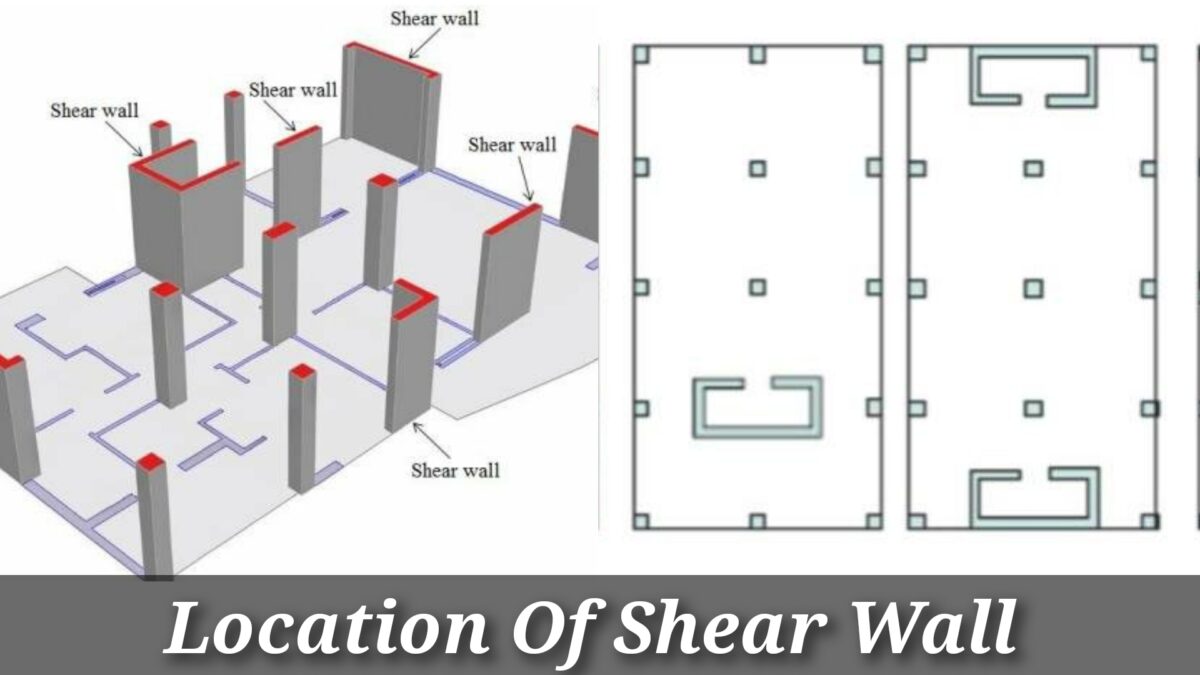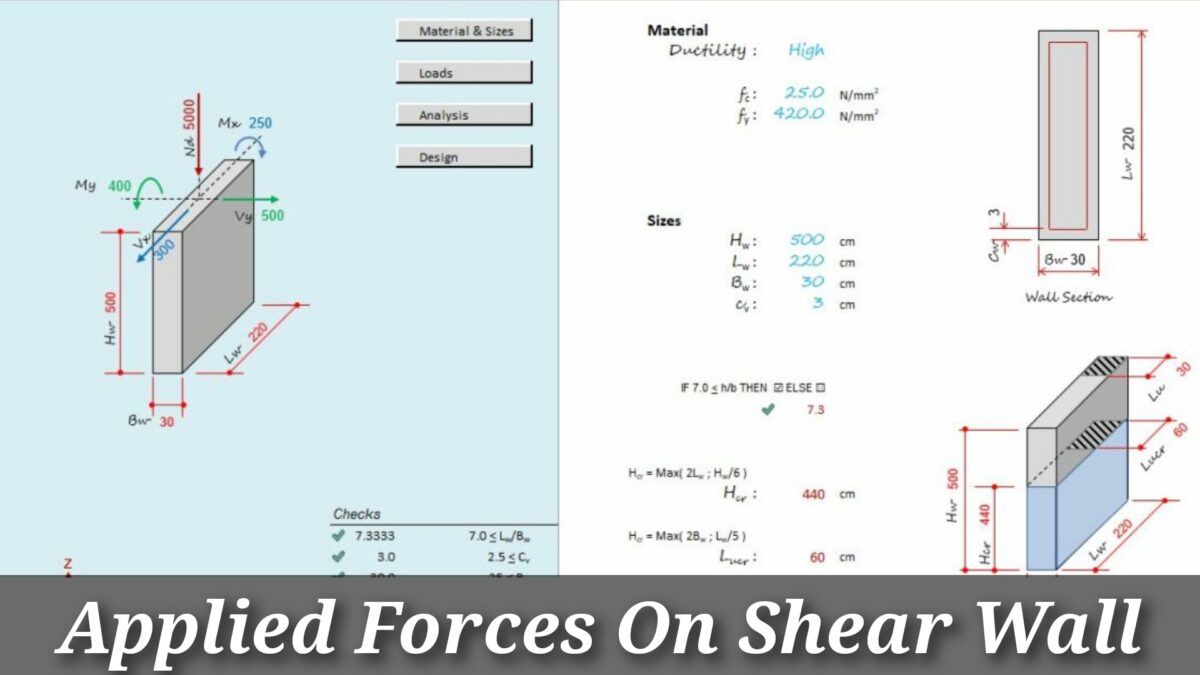Table of Contents
Shear Wall Definition
A shear wall is a vertical structural element that resists lateral forces like wind, earthquake, and other horizontal loads. It stiffens the building or structure to withstand the applied forces and transfer them to the foundation, preventing deformation or collapse.
Engineers typically design shear walls in areas with high seismic activity or wind loads and locate them at the perimeter or center of the building to provide maximum support. Shear walls play a crucial role in many building designs, ensuring stability and safety for occupants during natural disasters or extreme weather events.
What Is Shear Wall?
A shear wall is a vertical element used to withstand lateral forces such as wind and seismic forces acting on a building structure. It works as a vertical cantilever beam supported at the ground carrying vertical load collectively with columns. Shear walls are primarily used in tall buildings.

In the past two decades, shear walls became an essential part of high-rise buildings. As a part of an earthquake building design, these walls are provided in building plans to decrease lateral displacements under earthquake loads.
Purpose Of Shear Walls
Shear walls are mainly used for:
- To stand firm against lateral loads of earthquake and wind.
- To withstand gravity or vertical loads due to its self-weight and other living or moving loads.
- To resist shear as well as uplift forces on the structure.
- To increase the strength and stability of a structure.
- To provide sufficient stiffness to the structure.
Location Of Shear Wall In A Building
There are primarily two arrangements of shear walls; one is placed at the edges of the building which could be the either plain or flanged shape. The other is located inside the building in the shape of core walls or channel sections.

In highrise buildings, shear walls are mostly located at the center of the building normally in the form of a core wall system to accommodate vertical translation systems such as lifts.
Forces On Shear Wall

Shear walls mainly resist two types of forces;
- Shear force.
- Uplift force.
1. Shear Force:
Shear forces are produced in buildings due to ground movement and lateral forces like wind and waves. Shear forces act throughout the height of the wall between the top and bottom shear wall connections.
2. Uplift Force:
Uplift forces are produced on shear walls owing to horizontal forces acting on the top of the wall. Uplift forces try to lift up one end of the wall and push the other end down. Uplift forces create a greater effect on tall short walls and less effect on low long walls. Sometimes, sheer walls need to hold down devices to provide essential uplift resistance.
Classification Of Shear Walls:
- Simple rectangular types and flanged walls.
- Coupled shear walls.
- Rigid frame shear walls.
- Framed walls with in filled frames.
- Column supported shear walls.
- Core type shear walls.
Types Of Shear Walls:
1. RC Shear Wall:
RC Shear Wall is the most common type of shear wall which consists of reinforced concrete walls and RC slabs. The thickness of the walls normally varies from 140 mm to 150 mm. These walls are generally uninterrupted throughout the building’s height. Even so, discontinuous walls might be constructed on the street from or basement level for parking space.
2. Steel Plate Shear Wall:
Mostly, steel plate shear walls consist of steel plates, boundary columns, and horizontal floor beams. The steel plate wall and boundary columns work as vertical plate girders where the columns act as flanges and steel plates act as their web. These kinds of shear walls can be used effectively in highly seismic areas. Even so, it may be more costly than other types of shear walls.
3. Plywood Shear Wall:
Plywood shear walls are comprised of plywood, chords, and base connections. Plywoods transfer shear forces, chords oppose tension and compression and base connections transfer shear to the foundation.
4. RC Hollow Concrete Block Masonry Wall:
These types of walls are constructed by providing steel reinforcement both in the vertical and horizontal directions of masonry blocks. RHCBM walls counter lateral seismic loads and safely withstand earthquakes, This construction system is called as shear wall diaphragm concept. It gives three-dimensional stability to a building.
5. Mid-ply Shear Wall:
It is a fresh concept in shear wall design. One-ply of sheathing material is placed at the center of the wall between a series of pairs of studs and plates oriented in a 90° rotated position relative to these in standard shear walls. To protect from brittle failure at the end stud due to high tension forces, steel rods are used at each end of the mid ply wall. Mid ply walls have super survival characteristics under earthquake loading and have a dynamic load-carrying capacity of more than three times compared to standard shear walls.
Advantages Of Shear Walls:
The different advantages of shear walls are listed below:
- Shear walls supply more strength, stability, and stiffness to a building.
- Decrease lateral sway of a building.
- Easy to build and easily implemented at the site.
- Thinner walls, thus lightweight.
- Efficient in minimizing earthquake damage in structural and non-structural elements.
- Cost-effective.
- Fast-paced construction.
- Best performance.
Faqs
Engineers provide shear walls in buildings to resist lateral forces, such as wind or earthquake loads, and to transfer them to the building’s foundation, thereby providing stability and strength to the building’s structure.
Shear walls absorb the lateral forces acting on the building and transfer them to the foundation, thus providing maximum support. They are typically made of reinforced concrete, masonry, or wood and are strategically placed throughout the building.
Shear walls are typically required in buildings located in areas prone to high winds or seismic activity. The number and size of shear walls needed in a building depend on the building’s design, height, and location.
Yes, engineers can add shear walls to existing buildings to increase their resistance to lateral forces. However, this process can be complex and may require structural modifications to the building’s foundation and structure.
Shear walls provide numerous benefits in building design, including increased stability and safety during seismic events or high winds, improved building performance, and reduced damage and repair costs in the event of a disaster. They also allow for more open floor plans and flexible design options.
